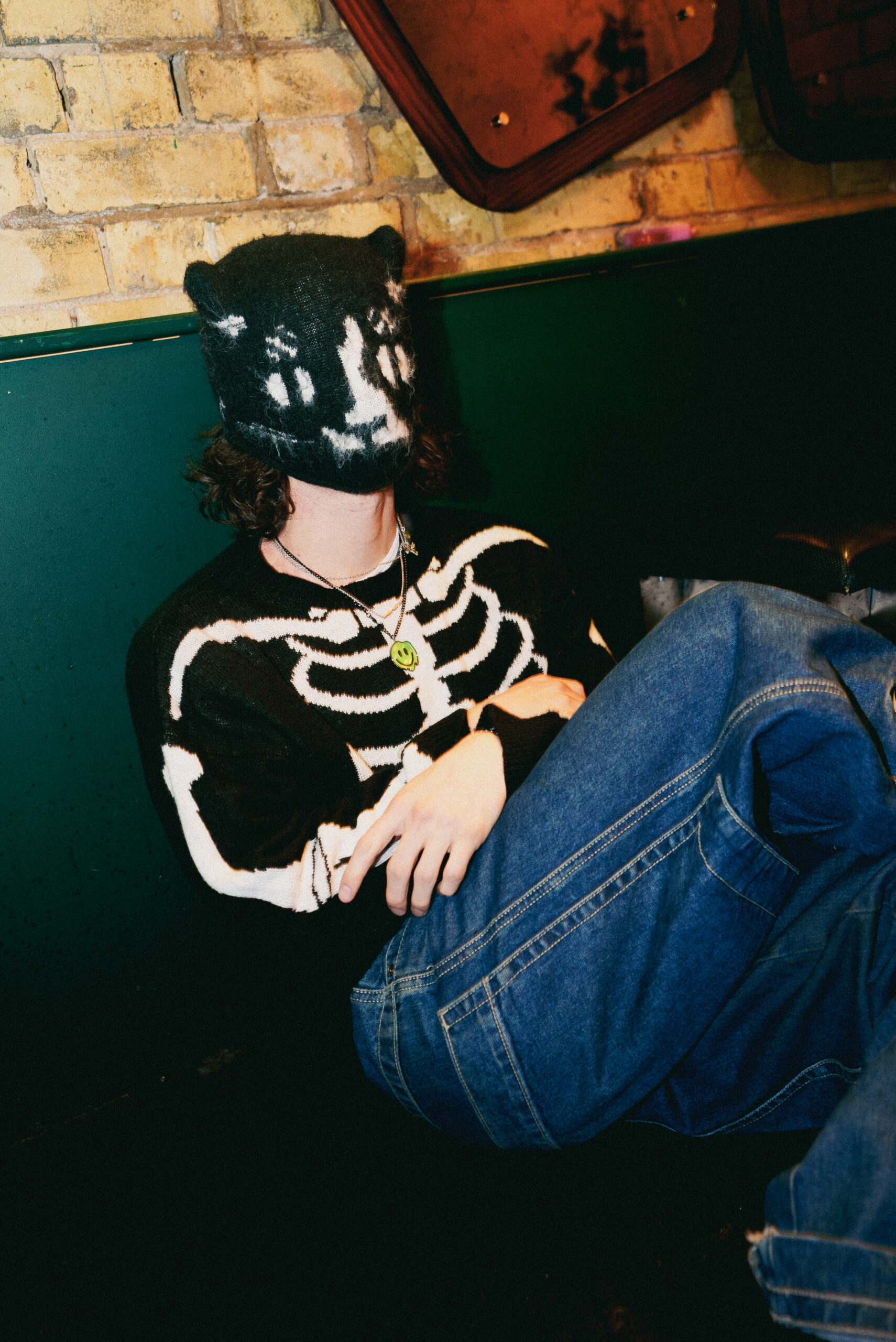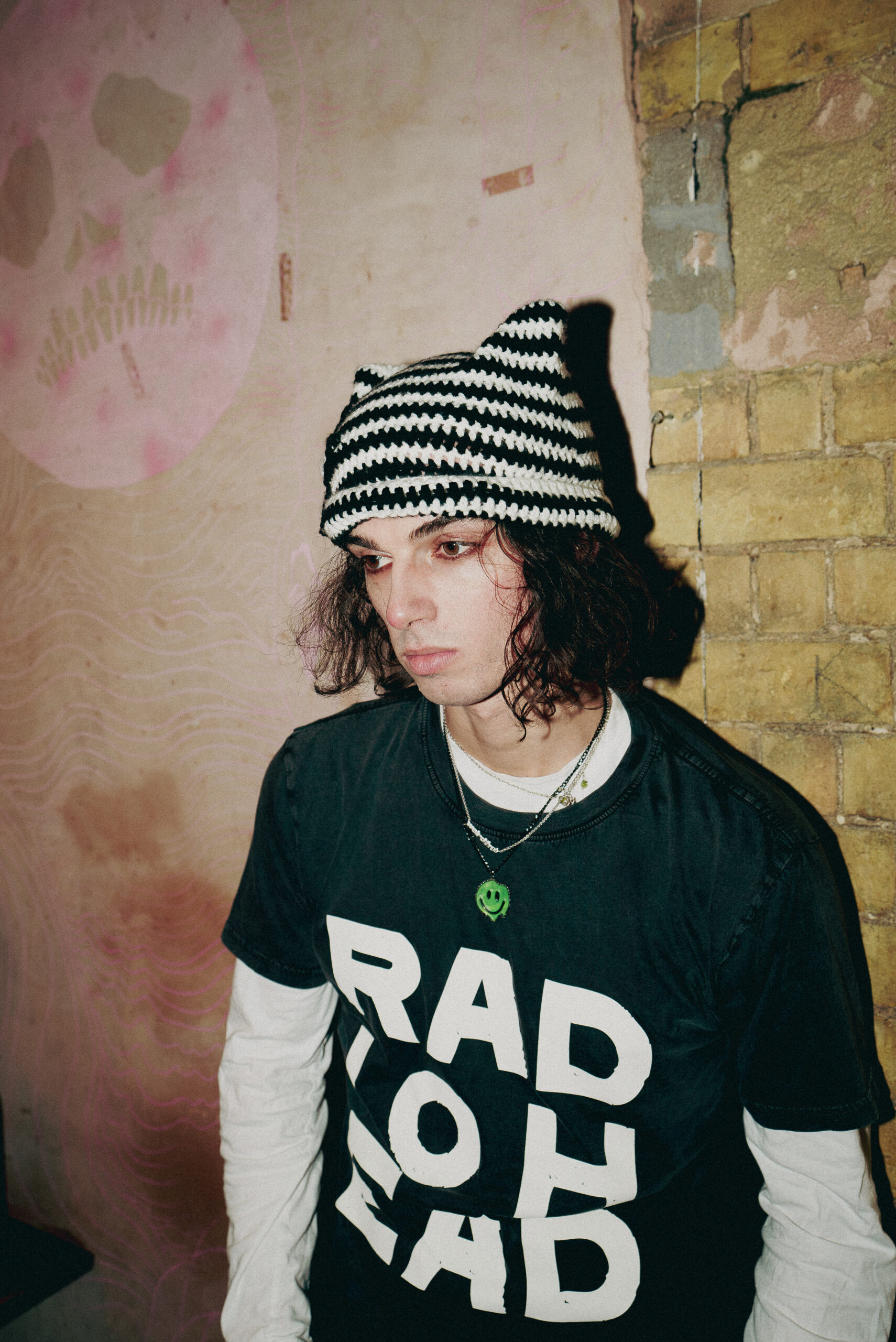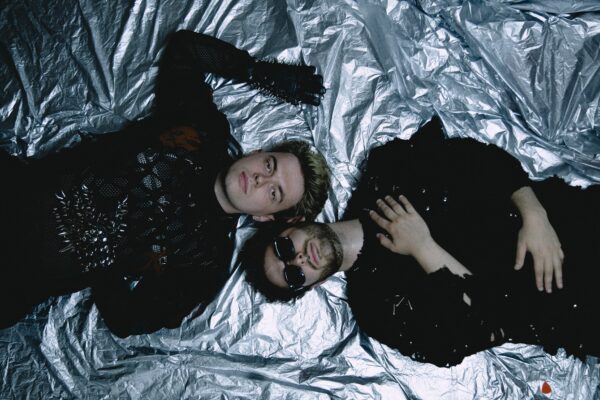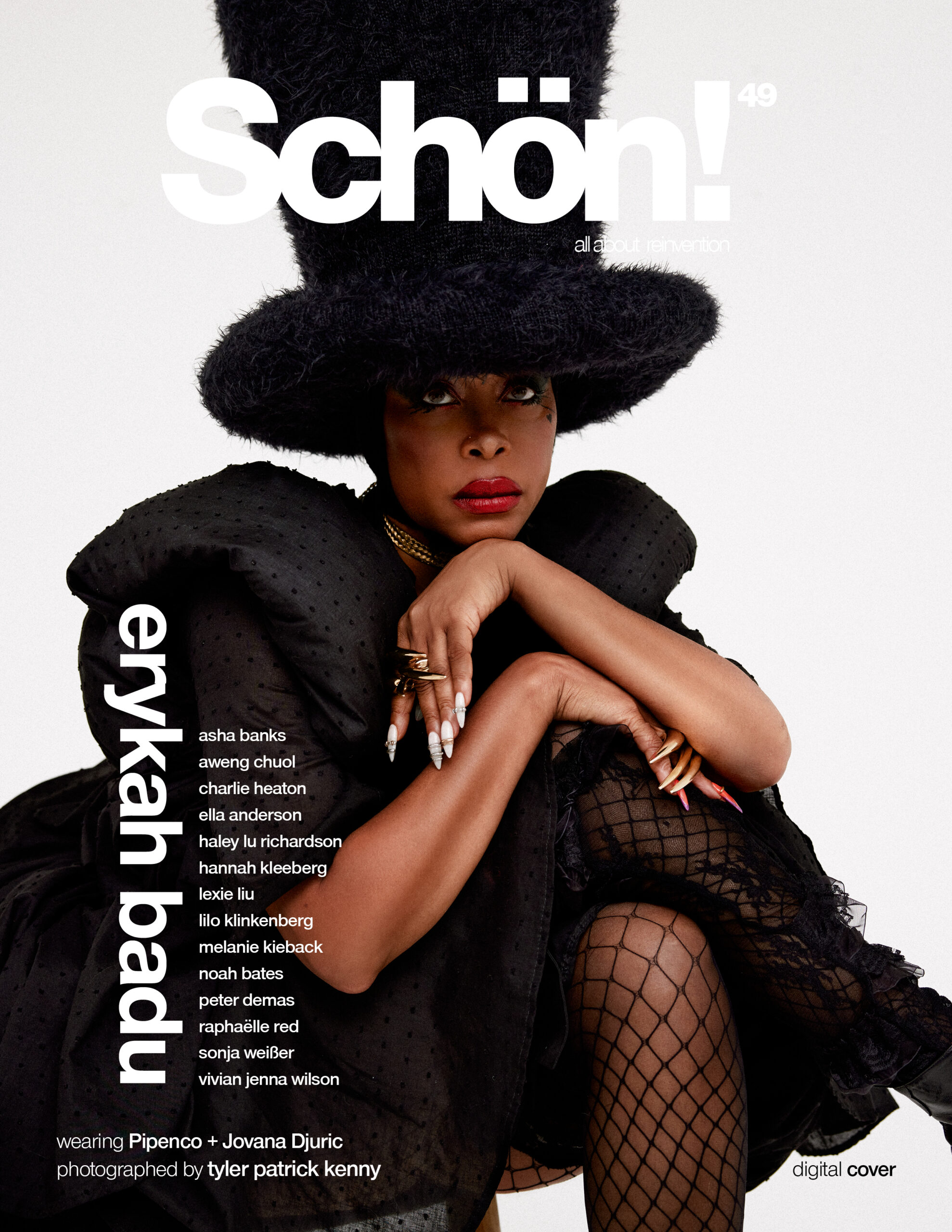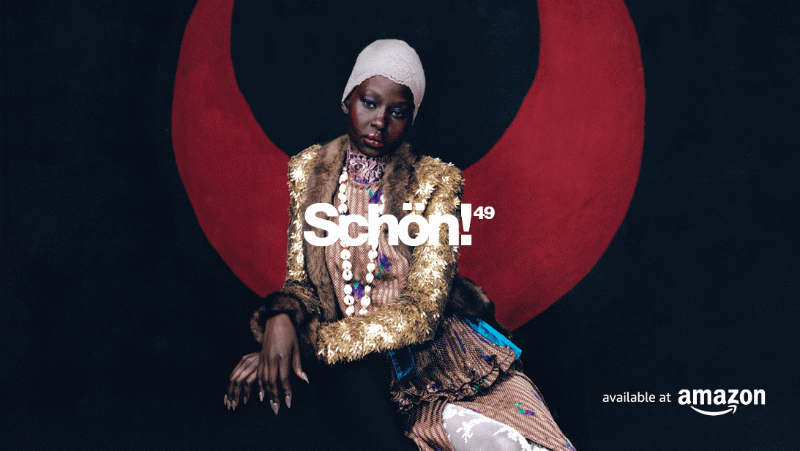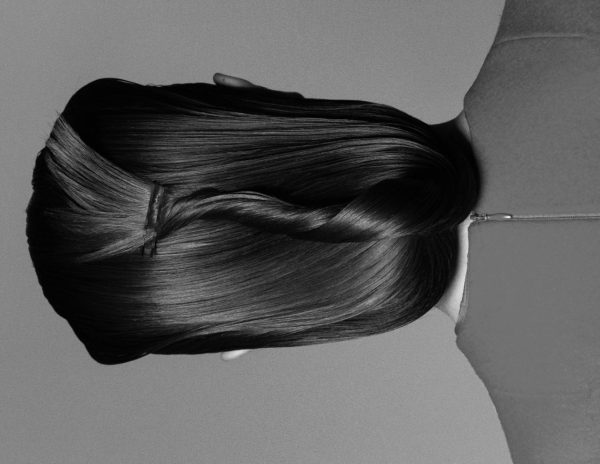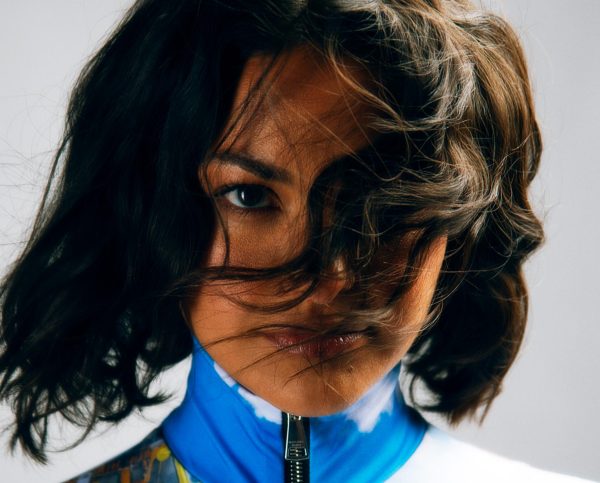
dress, bodysuit + shoes. Moschino
opposite
shirt. AREA
skirt. Levi’s
shoes. Loewe
tie. Saint Laurent
In the multifaceted world of entertainment, where storytelling takes myriad forms, few individuals manage to seamlessly navigate diverse realms with as much grace and talent as Megan Suri. Renowned for her compelling performances in both film and television, Suri has recently captivated audiences with her lead role in the horror film It Lives Inside. However, her journey extends beyond the realms of supernatural thrillers, as she effortlessly transitions to the high fashion scene, having recently participated in a major New York Fashion show with the esteemed designer Jason Wu.
In conversation with Schön!, Suri discusses her experiences, insights, and aspirations — from her meticulous preparation for characters in the supernatural to the magical moments she finds in high fashion.

dress + belt . Louis Vuitton
boots. Valentino Garavani
Let’s dive into your latest project, It Lives Inside. Your venture into this horror genre marks a departure from your previous roles. What captivated you about this genre, especially in the supernatural realm, and how did you go about preparing for a character in such an otherworldly setting?
That’s an excellent question. My fascination with the horror genre goes back to my childhood; I’ve been a devoted horror fan for as long as I can remember. Watching these movies has been a part of my life since a very young age – perhaps too young. Pursuing a role in a horror film has always been on my career bucket list. So when the opportunity for It Lives Inside came about, I was beyond thrilled. I would have gladly taken any role in a horror film, even if it meant meeting an early death scene. That’s how eager I was to be part of the genre.
But being able to lead a movie centred around South Asian characters was what made this project even more special. To be honest, I couldn’t believe it when I first heard about it. I initially thought it might just be an idea floating around, not something that would materialize to the extent it did. As for preparation, working with Bishal Dutta, our writer and director, was an incredibly collaborative process. From the moment I was cast, we engaged in weekly Zoom sessions leading up to the shoot. These sessions were dedicated to discussing the character and delving into the intricacies of the role. The preparation process was pretty extensive and helped me feel ready to play Sam when we finally stepped onto the set.
Moving on to another aspect of your character in the film—she initially rejects her Indian heritage. How did you approach portraying this character’s journey, and what aspects of her struggle did you find most compelling as an actor?
When it comes to representation, especially after my experience with Never Have I Ever, I’ve learned the profound impact it can have on a community. There’s a significant responsibility to authentically portray such narratives, keeping in mind that it’s not a one-size-fits-all experience. Bishal and I had insightful conversations about his own experiences as an immigrant, adjusting to American culture, and I drew from my encounters.
As for the compelling aspects of her struggle, I’d say it’s the entirety of it. It may sound like a generic answer, but in my career, I’ve played characters confined to stereotypes in the past. In this role, I had the opportunity to portray a fully rounded, complex character with real, valid emotions—a journey that resonates with many people. That, for me, was the appealing nature of this role, revisiting parts of my own life and witnessing the profound growth.

dress, bodysuit + shoes. Moschino
opposite
jacket. MSGM
earrings. Moschino
It’s fantastic to hear about the success of It Lives Inside at South by Southwest. How was the experience of showcasing the film at such a prominent festival, and how do you believe it has influenced the perception of the film?
MS: Absolutely, it was a surreal experience. Some of my favourite movies and those I admire have been featured at South by Southwest, so when we received the news of our acceptance, the excitement was overwhelming. It felt like everything fell into place perfectly. Winning the Midnighters Audience Award was the cherry on top. The recognition at such a renowned festival conveyed to theatres that there was genuine fan appreciation. It played a pivotal role in convincing theatres to release the movie globally, allowing it to be seen on the big screen. Beyond that, showcasing a film led by Brown individuals at such a prestigious festival was a gift in itself. It reinforced the importance of our stories, letting us express that our narratives matter. Though uncertain about the audience’s response, we found that people showed up, resonated with the film, and enjoyed it.
I’m glad you enjoyed it. Transitioning from a successful streaming show like Never Have I Ever to taking the lead in a horror film is quite a shift. How do you navigate between genres, and what roles do you find most challenging and rewarding?
It has been an incredibly gratifying experience, and I’m thankful for what the show has meant to audiences worldwide. Fans from diverse backgrounds and age groups have expressed their love for the show, making it a rare and special journey. On a personal level, Never Have I Ever opened my eyes to the kinds of roles I wanted to pursue.
Playing Aneesa, a character who deviated from the typical Brown characters seen on TV, showed me the impact of portraying someone different. Aneesa was a cool, athletic, carefree girl who wasn’t necessarily the smartest in school, and that uniqueness made her special. This realization fueled my interest in exploring diverse roles and the transformative power of embodying different characters. The appeal for me now lies in delving into different genres. In real life, I’m quite boring, so playing characters like myself holds no allure. As an actor, a significant part of the attraction is the desire to escape my reality and become someone else. While I incorporate aspects of myself into characters, the true challenge lies in portraying individuals I haven’t walked in the shoes of yet. Figuring out the nuances and complexities of another human being is both rewarding and challenging. Therefore, every role, especially those I find intriguing, presents its unique set of challenges and rewards. I strive to ensure there’s a variety in the roles I take on, keeping the journey dynamic and fulfilling.

jacket. MSGM
earrings. Moschino
opposite
shirt. AREA
skirt. Levi’s
shoes. Loewe
tie. Saint Laurent
Reflecting on your portrayal of Aneesa in Never Have I Ever, which received acclaim for its diverse representation, how do you see its impact on the broader television landscape now?
I believe Never Have I Ever shattered the notion that streaming services couldn’t cast Brown people as leads because it wouldn’t attract viewers. The show’s immense success debunked that notion entirely. It served as a trailblazer, showcasing that a story centred around Brown characters can resonate with audiences globally. It has paved the way for stories that reflect various perspectives, breaking away from the typical narratives we often see. An important aspect, as you rightly put it, is that being Brown is not a monolithic experience. Each individual has nuances, and the show contributed to showcasing part of this diversity within the Brown community.
That’s truly impactful. Your efforts in bringing these diverse stories to life are commendable. Now, moving on to Companion, what elements of the script or the team captivated you, and how do you see it playing a pivotal role in shaping your evolution as an actor?
The appeal of Companion lies in its fun and exciting story. The team behind the movie, particularly those who produced Barbarian, caught my attention. I had watched Barbarian in theatres during the reshoots for It Lives Inside, and I had a visercal experience watching it. When Companion came around, and I realized it was the same team, I knew there was something special about it. Interestingly, I initially doubted my audition and decided not to send it to my team. However, when my team informed me that the role was still open and encouraged me to try again, I decided to give it another shot.
This time, I went into the audition with a carefree attitude, thinking, “If it works, great; if not, that’s fine too.” I didn’t even watch my final tape to avoid overanalyzing it. To my surprise, I later received the call that I had booked the role, and it was an incredibly surreal moment. An important reminder to never give up. The script is brilliant, the cast is incredible, and the producing team is fantastic. I’m grateful for the opportunity and excited to be part of this one.
Navigating Hollywood to lead a Neon film is kind of a monumental achievement. Congrats on that. Could you delve into the challenges you confronted while making your mark in the industry, and in what ways do you envision this role contributing to a transformative shift in today’s landscape?
Absolutely, navigating Hollywood and leading a neon film has been a journey, and I appreciate the congrats. As for the challenges, I’m still in the process of making my mark, with a long road ahead. However, there has been a noticeable shift from when I first started. The kinds of roles I now get to audition for are more diverse and exciting. Regarding contributing to a transformative shift, I’m interested in playing interesting characters—complex, flawed, and inherently human. While my ethnicity is part of who I am, it’s not the focal point of the characters I want to portray. I believe that playing compelling characters, regardless of their cultural background, can move the needle forward in terms of representation. I hope to contribute to broadening perspectives and creating connections with audiences. Additionally, for individuals who might not typically see themselves in mainstream media, I hope they can find inspiration and see the possibilities.

shirt. AREA
skirt. Levi’s
tie. Saint Laurent
Recently, you were featured in a prominent New York Fashion show alongside the talented designer Jason Wu. How do you perceive the intersection between fashion and your work in film and TV? And how does this amalgamation contribute to your artistic expression as an actor and an individual?
Delving into the world of high fashion has been a relatively recent exploration for me. As a woman in her twenties, fashion holds a significant place in my life—it always has. When I’m immersed in a character, extensive preparation is crucial, but I feel like I truly understand a character when I step into the costume. The moment of donning a character’s attire feels magical, and it’s then that I feel I truly grasp the essence of who they are. Walking in their shoes, everything falls into place, creating a deep connection. In a parallel sense, my engagement with fashion has been instrumental in unfolding more layers of my own identity. While I’m not a method actor, years of being in the industry have somewhat impeded my exploration during crucial developmental stages. Fashion, however, has become a powerful tool for self-discovery. It aids me in understanding my interests, and what makes me feel beautiful, confident, and, frankly, badass. This ongoing journey of self-awareness through fashion directly impacts the choices I make for the characters I want to portray.
Moreover, the emotions evoked by different styles of clothing serve as inspiration and influence my understanding of characters on a deeper level. Fashion is undeniably an art form, and artists create art. This close connection between art and my artistic expression as an actor is something I find profound and continually enriching.
I recently came across a quote by Oscar Wilde that aligns with this sentiment. Wilde said that if you like something, you like it for what it is, as art does not necessarily require a profound philosophical underpinning. In that regard, you embody this idea perfectly.
Absolutely, and I’m glad you brought this up. There’s often pressure, especially on individuals of South Asian descent, to create art that sparks deep conversations or demands intense analysis. But I believe art doesn’t always have to be dissected. Take, for instance, my involvement in It Lives Inside, a horror movie. If people watch it and have an intellectual conversation afterwards, that’s fantastic. Yet, sometimes the purpose is simply to enjoy a scary movie and then move on with life. As an actor, part of my work is self-expression and understanding different characters.
However, as an entertainer, there’s a significant aspect of providing an escape for the audience. It’s about allowing people to immerse themselves in a different world temporarily and then return to their everyday lives. I feel there’s an unspoken expectation, especially for individuals of South Asian origin, that our work must always initiate meaningful conversations. But sometimes, it’s just about doing something because I liked it, and that’s enough. We don’t always need to make it a big deal. The pressure to constantly outdo ourselves can hinder the creative process. It’s essential to focus on creating and letting people connect with the work as they naturally do. The goal is to make things that people enjoy without the burden of perfection. This approach, I believe, contributes to a more authentic and fulfilling artistic journey.
Perfectly said! Looking ahead, are there specific directors or types of projects you aspire to collaborate with or be a part of in the future?
After working with someone as detailed and knowledgeable in their field as Bishal, I hope to work with directors who share that passion. While Christopher Nolan and other greats like Greta Gerwig are among my favourites, what matters most to me is collaborating with directors who are true cinephiles and have a deep love for the art of cinema. I want to work with individuals from whom I can learn and who bring a genuine passion for the craft. Directors, in my opinion, are some of the best teachers, always offering room for improvement and growth. So, the focus now is not just on the projects but also on the individuals I’ll be working with and whether there’s excitement and a shared love for the art.

dress. STINE GOYA
boots. Marc Jacobs
opposite
dress, bodysuit + shoes. Moschino
photography. BR Carr @ Sibling Artists
fashion. Trudy Nelson
talent. Megan Suri
hair. Kat Thompson @ The Wall Group using Living Proof + GHD
make up. Kendall Fedail @ The Wall Group using Monika Blunder Beauty + Tower 28
creative production. Clara La Rosa
location. Mountain House, LA
interview. Ishika Paruthi










































































